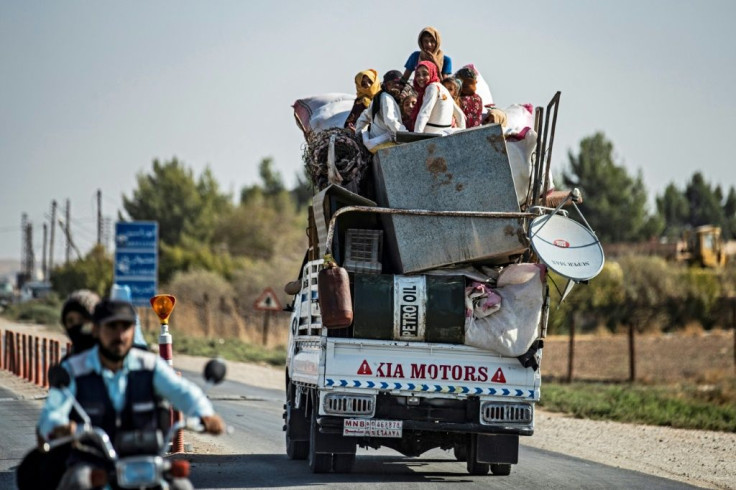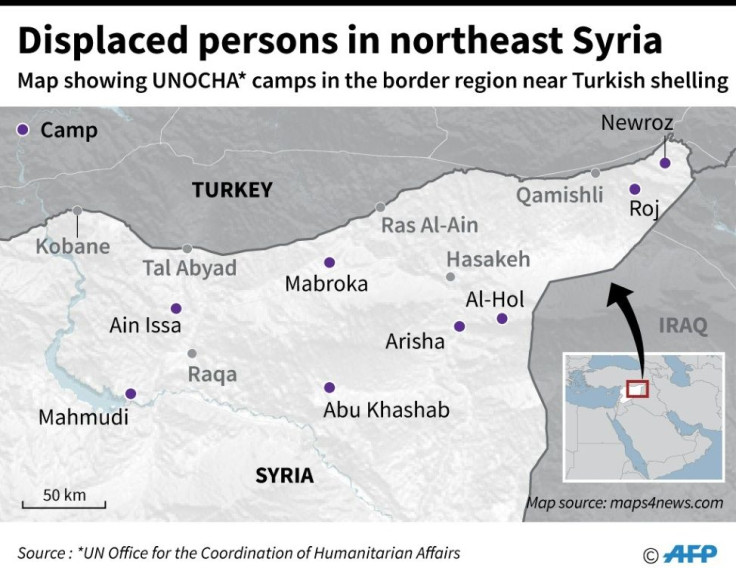In Syria, History Repeats Itself For Displaced Kurds

For the second time in two years, Jihan and her family had to pack their bags and abandon their home in northern Syria because of a Turkish invasion.
As she picked her way through the belongings other displaced families had strewn across the school yard, the 47-year-old mother felt a mix of anger and weary deja vu.
"We don't know where to go," she said, moments after reaching the school in the city Hasakeh which the autonomous Kurdish administration turned into a shelter.
According to the United Nations, 70,000 people have had to flee their homes since Turkey launched a cross-border offensive on Kurdish-controlled areas on Wednesday.
It is the third time since the start of the Syria conflict in 2011 that Turkey has invaded northern Syria.

The last time was in early 2018, when Turkish forces and their Syrian proxies seized the Kurdish-majority area of Afrin, causing another major wave of displacement.
Jihan and her family fled her native Afrin then and settled in Kobane, another mostly Kurdish border town which suffered major destruction earlier in the war.
On Thursday, she had to flee again and join the flock of civilians who have streaming to Hasakeh, an eastern city which has not been targeted by Turkey so far.

"What does Erdogan want from us?," she raged, referring to the Turkish president. "Is it all simply because we are Kurds?"
She and most other displaced Kurds have been unable to return to Afrin, where mostly Sunni Arab former rebels loyal to Ankara have settled.
Some of the same former rebels, who were defeated by regime forces and cannot return to their own native regions in Syria, are now supporting Turkey's latest operation.

History is repeating itself in many ways: Turkey launched its attack on Afrin last year after Russian forces quit positions in the area.
'Sold us out'
This week, Ankara and its proxies launched their offensive two days after US forces pulled back from the border, leaving their Kurdish allies in the lurch.
"In Afrin, Russia sold us out. Today, America is selling us out," is how Jihan summed it up.
In the school yard in Hasakeh, the displaced children play on a rusty old swing while their parents start unpacking their bags and feed the youngest.
Most of the displaced are from the largest towns on the border, including Kobane, Tal Abyad and Ras al-Ain.
"Following the emergency... people went to Tall Tamr, Hasakeh and surrounding villages. We have requisitioned three schools to house the people," said Majida Amin, a local official in charge of displaced people.
She said that the number of people who were given shelter in the first school was 220 and increasing with every hour.
Amin said that little help was available from local aid groups and called on the international community to step up and organise the emergency humanitarian response.
She explained that most of the people who fled their homes try to move in with relatives who live in safer areas before coming to the newly opened shelters.
Since Turkish jets and artillery started raining bombs and shells, families can be seen heading away from the border, some of them walking down roads with bags and bundles on their backs.
Others like Ibrahim Fares and his family were able to squeeze in a car to leave Ras al-Ain, one of the towns hardest hit.
"Now we don't know where to go and where we will sleep," the 28-year-old said.
© Copyright AFP 2024. All rights reserved.







